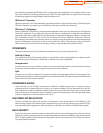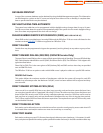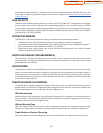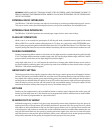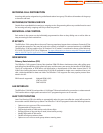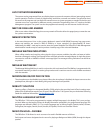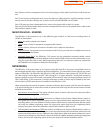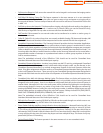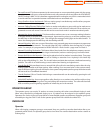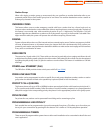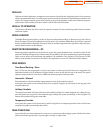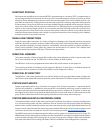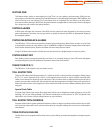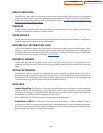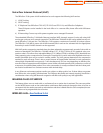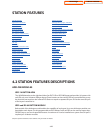
•Forward External:This feature operates in the same manner as a non networked system with the excep-
tion that,because calls across a network link are trunk calls,network calls do not follow the ICM FWD EXT
ON/OFF setting in MMC 210.It is therefore suggested that this setting be set to ON in a networked switch
to avoid confusion in operation between networked and non networked calls.
•G
roup Overflow Across the Network: Calls to a station group in one Node may overflow after a program-
mable time to another station group in another Node.
•Intercom Calling/Discret
e Dialing Plan: Station to station and station to group calls can be made across
the network link without having to dial an access code for a call within the network.LCR can also be pro-
grammed to route calls across a network link and to access local trunks in another networked system.
•M
essage Key Across the Network: This feature allows station users to set a message waiting indication
to another station in another Node in the network. Upon receiving a busy or no-answer condition,press
the MSG key or dial the feature code. This will light the message waiting light at the called station. To
return the message press the MSG key with the flashing red LED.
•N
etwork Page Key: With one or more of these keys users may make page announcements to page zones
in others Nodes in the Network. The network page (NP) key is different than the Page key in a single
node. For example, It is programmed as NP024 where 02 = Node 2 and 4 = page zone 4 in Node 2.
•Networ
k Trunk Ring Destination: This feature allows lines/trunks from the telephone company connect-
ed to one Node to be programmed to ring at a destination (station or station group) in another Node.
•R
emote Hold Across the Network: Calls may be placed on hold at stations in another Node. Then page
that Node and announce that there is a call on holding on extension 2xxx. Anybody in this Node may
pick up the call by dialing 12 + 2xxx. This is useful when one Node does not have a dedicated answering
position. The caller is on Hold listening to music rather then listening to ringback tone.
•T
ransfer Recall:Calls transferred across a network link will recall to the transferring station after the orig-
inating system transfer recall timer expires. After recalling, if not answered prior to that systems atten-
dant recall timer expiring,the call will recall to that systems designated operator group.Attendant recalls
will not recall to a ‘Centralized Attendant”.
•T
ransfer Retrieve: Calls on Transfer Hold during a screened transfer can be retrieved by pressing the call
button for that call.
•V
oice Mail Transfer Key: Users may transfer a caller directly to a co-workers voice mail box with out ring-
ing their telephone by pressing the VT key and dialing their extension number. The caller will then hear
that co-workers personal greeting regardless of where they are in the network.
OPERATOR GROUP
The operator group can contain 32 stations to answer incoming calls when unconditional ringing is used.
When using sequential or distributed ringing up to 32 stations may be assigned to the operator group.
Operators can use the In/Out of Group feature to meet flexible operator requirements.Operator groups are
selectable per ring plan. Dial “0”calls to the operator group flash with a distinctive amber LED.
OVERFLOW
Operator
When calls ringing a operator group go unanswered, they can overflow to another destination after a pro-
grammed period of time.The operator group has its own timer.The overflow destination can be a station or
station group.
4.21
Home Page
Table of Contents



